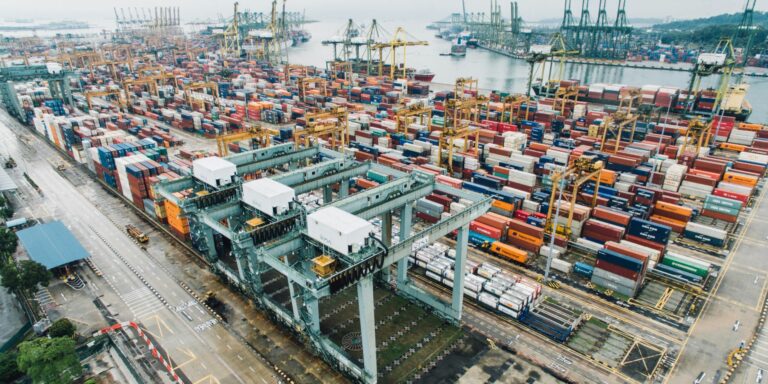U.S. equity markets fell sharply today as a dual wave of economic unease—a disappointing jobs report and an aggressive new tariff policy—shook investor confidence and triggered a broad-based selloff. The developments, which come amid already delicate global financial conditions, have sparked renewed fears of an economic slowdown and prolonged market volatility.
The July jobs report, released this morning by the Department of Labor, showed that the U.S. economy added only 73,000 new nonfarm payroll jobs, falling well short of economists’ expectations and reflecting a stark deceleration from the pace earlier this year. Compounding the disappointment, the report revised job creation figures for May and June downward by a combined 258,000, further dampening sentiment. The unemployment rate edged up from 4.0% to 4.2%, signaling that the labor market may be losing momentum as hiring cools across key sectors including retail, manufacturing, and logistics.
This labor market weakness comes at a critical juncture, as inflationary pressures have already begun to pinch household purchasing power and corporate margins. The cooling jobs data has intensified speculation that the Federal Reserve may respond with a rate cut as early as its next policy meeting in September. Yields on U.S. Treasury bonds slipped in response, as investors rotated into safer assets amid growing economic uncertainty.
Read Also: https://nvtoday.com/u-s-stock-markets-show-modest-gains-amid-ongoing-u-s-china-trade-talks/
Adding to the turbulence, President Donald Trump signed an executive order today imposing a sweeping new tariff regime aimed at restructuring global trade relationships. Under the new order, a universal baseline import tariff of 10% will apply to nearly all goods entering the United States, with elevated rates between 20% and 41% targeting specific nations accused of trade imbalances or unfair practices. These include long-standing allies such as Canada, the European Union, India, Taiwan, Switzerland, and South Korea, among others. While some countries were granted exemptions or reduced rates following bilateral negotiations, the effective average tariff rate has jumped significantly—from 2.3% in 2024 to an estimated 18% under the new regime.
The stock market reaction was immediate and severe. The S&P 500 index dropped 1.6%, shedding over 80 points, while the Dow Jones Industrial Average fell 542 points, or 1.2%, closing at 43,588. The Nasdaq Composite, heavily weighted with technology stocks particularly vulnerable to global supply chain disruptions, plunged 2.2%, losing nearly 472 points. The Russell 2000 index of small-cap companies also fell by approximately 2%, reflecting broad investor concern across market segments.
Market analysts say the downturn marks the worst single-day performance for U.S. indexes since May and highlights growing concerns about the resilience of the U.S. economy in the face of mounting external pressures. Many had anticipated that the administration’s tariff threats were largely rhetorical—a strategy some analysts jokingly labeled the “TACO trade” (Trump Always Chickens Out)—but today’s hardline actions dispelled those assumptions and reintroduced uncertainty to global trade negotiations.
Traders are now recalibrating expectations for the months ahead. Some analysts argue that if trade discussions resume constructively, markets could recover on fundamentals, particularly if interest rate relief is delivered in September. Others warn that prolonged trade friction, especially if met with retaliatory tariffs from affected nations, could raise costs for consumers, depress corporate earnings, and weigh on GDP growth.
International markets echoed Wall Street’s decline. The FTSE 100 in London slipped by 0.5% as investors assessed the potential fallout from disrupted trade flows. Asian markets, which closed earlier, also declined in reaction to reports of the impending tariffs, with the Hang Seng Index in Hong Kong and the Nikkei 225 in Tokyo both posting significant losses.
The tariff move has drawn criticism from multiple corners of the business community. Industry groups representing retailers, manufacturers, and agriculture warned that the sudden imposition of such broad tariffs could lead to price hikes, product shortages, and logistical chaos. Small and mid-sized enterprises, in particular, are expected to face the brunt of the adjustment, as many lack the resources to quickly shift suppliers or absorb higher input costs. Executives also expressed concern about the lack of clarity in the new rules, including how enforcement will handle transshipment, exemptions, and delayed cargo already en route.
Despite the market’s sharp reaction, White House officials defended the move, framing it as a necessary step toward restoring “fair and reciprocal trade” and reasserting American economic sovereignty. Administration spokespersons argued that existing trade deficits had long undermined domestic industries and that the new framework would incentivize more equitable agreements.
Looking forward, the coming weeks could prove pivotal. The Federal Reserve is expected to weigh incoming labor and inflation data closely before its September meeting. Meanwhile, diplomatic overtures from affected nations may determine whether the U.S. administration softens or intensifies its tariff approach. In the absence of clear progress, however, the risk of a deeper market correction remains elevated.
Today’s sharp decline reflects more than just a reaction to weak jobs and higher tariffs—it underscores a broader sense of unease about the policy direction of the U.S. economy at a time of global fragility. Investors, businesses, and policymakers alike are watching closely for signs of stabilization or further disruption.


